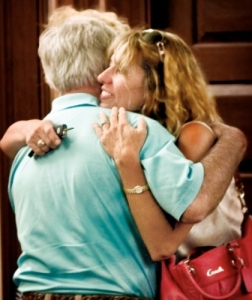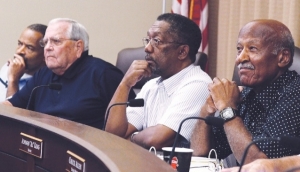City buys building
By Ty Johnson
Published in News on July 6, 2011 1:46 PM

News-Argus/MICHAEL BETTS
Al Grisette, president of the Arts Council of Wayne County, hugs Downtown Goldsboro Development Corp. executive director Julie Thompson after the City Council vote.

News-Argus/MICHAEL BETTS
From right, Mayor Al King, Councilman Don Chatman, Councilman Bob Waller and Councilman Michael Headen listen to the public's view on the purchase of the former Arts Council of Wayne County headquarters on East Ash Street and its potential use as an Air Force Museum.
Goldsboro's ties to Seymour Johnson Air Force Base might be about to get much stronger after the City Council voted Tuesday night to purchase the building owned by the Arts Council of Wayne County for use as a proposed Air Force museum honoring the 4th Fighter Wing.
The 7-0 vote came after a lengthy public comment period during which seven individuals spoke in favor of the purchase and Air Force museum idea. Mayor Al King permitted the public comment period to be moved ahead in the agenda to facilitate the large crowd that gathered to speak.
The purchase indirectly resulted in the realization of another city project: bringing the Arts Council downtown.
Arts Council Executive Director Sarah Merritt and President Al Grisette were on hand for the decision, which Mrs. Merritt had said was pivotal in the Arts Council's potential move to a new location at the corner of John and Walnut streets.
That move allows the Downtown Goldsboro Development Corp. to claim a $200,000 grant it received to promote the move. That grant will fund renovations to the first floor of the Annie Dove Handley building where the Arts Council will relocate. Mrs. Merritt said Friday that plans existed for her staff to move into the downtown facility by the end of this month.
The purchase price of the building will come from the occupancy tax fund in the amount of $475,000. The remaining $25,000 had already been transferred to the Arts Council during a May 10 budget ordinance as a non-refundable down payment on the structure.
The occupancy tax fund is a 5 percent tax on hotel visitors that is placed into a separate fund to be used for travel and tourism related projects. The tax was introduced in 1991 to eventually collect enough funds to support a civic center for the city.
Although the building's purchase has been approved, the council said following the meeting that there were no immediate plans for any renovations to the building.
District 3 Councilman Don Chatman said the building's placement on the market left the city with a short duration of time in which to buy the building, but promised a more lengthy process between the purchase and its possible implementation as an Air Force museum.
"We were sort of pushed for time," he said. "If we waited, we would lose the building, but we decided we wouldn't go any further without a comprehensive plan."
District 6 Councilman Jackie Warrick noted the outpouring of support for the plan during the public comment period of the board meeting and invoked Chat-man's language, saying "we're not going to rush into it."
He also said the purchase wasn't a bad deal at all because the council could always resell the building and get its money back.
District 2 Councilman Bob Waller also spoke on the possiblity of selling the building if the Air Force museum idea didn't pan out, adding that he would be the first to oppose the purchase if any money from the city's general fund was involved in the purchase.
District 1 Councilman Michael Headen also stressed that the funds for the building purchase were coming from the occupancy tax fund, a fund which has strict stipulations for what it can be used for.
But neither Chatman, Waller, Headen or District 4 Councilman Rev. Charles Williams could speak as to where the funding for the building's renovations would come from.
Waller and Williams said they didn't recall the $1.4 million estimate for renovations that was presented to council by engineer Jerry Hodge on May 2. The city contracted with Hodge to perform the structural analysis for $20,000, which was taken out of the occupancy tax fund.
King said two weeks ago that he wasn't familiar with that figure either, and pledged the city wouldn't be spending that kind of money on the building.
He said those costs were what was required for a museum featuring suspended planes and other high-end amenities.
Hodge suggested all of the repairs he outlined in his six-page report be performed, with special priority on the HVAC system and glass, which he estimated would cost $600,000. The electrical, plumbing and other upgrades, at $500,000, would be the next priority, followed by the $300,000 in roof and ceiling renovations. Williams called those figures "guesstimates."
When questioned about the mayor's June 9 statement that the city won't use all of its occupancy tax fund to renovate the building, the councilmen said they would have to defer to the mayor, opting not to comment.
The combined total of the occupancy tax fund's civic center and travel and tourism balances, Finance Director Kaye Scott said, is $2.1 million. The estimated $1.9 million of renovations would nearly wipe out the fund, although many variables exist as to if or which and when renovations would be done.
